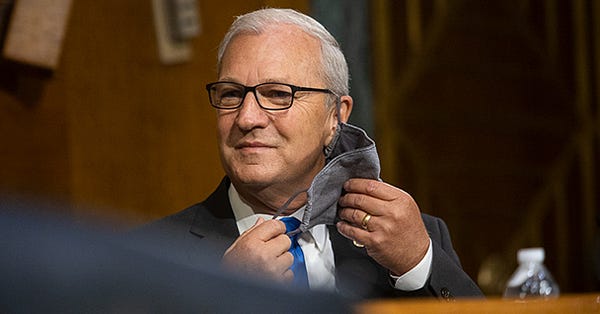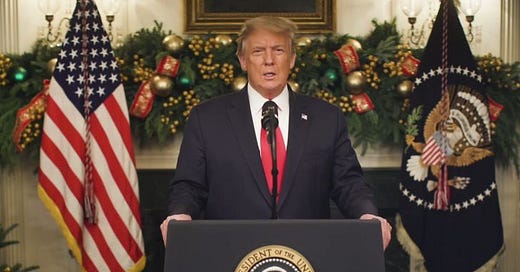Congress might pass a huge energy bill, and it's actually pretty great
Will there be a Christmas miracle?
Happy holidays, Voltlings!
What a time to be alive.
On Monday, Congress passed an enormous $900 billion coronavirus relief bill attached to an enormous $1.4 trillion omnibus spending bill, adding up to a super-enormous $2.3 trillion megabill — at 5,593 pages, the longest bill Congress has ever passed.
Buried in that megabill is the most substantial energy legislation passed in the US in over a decade. (I discuss it below.)
It was supposed to be smooth sailing after that, but then … Trump.
Perhaps he grew tired of not being the center of attention. Perhaps he wanted to screw Mitch McConnell in revenge for the Senate majority leader acknowledging that he lost the election. Perhaps he just saw something on Fox that didn’t sit well.
For whatever reason, on Tuesday evening he issued a video scorning the $600 relief checks in the bill, demanding that they be at least $2,000, denouncing what he called wasteful spending elsewhere in the bill, and threatening to veto the whole thing.
“The video landed like a sonic boom in Washington,” reported The Washington Post. “His own aides were stunned. Congressional aides were stunned. Stock market futures quickly slumped on the prospect that the economic aid could be in doubt.”
House Speaker Nancy Pelosi then called Trump’s bluff, saying that she could quickly pass a bill with $2,000 checks through the House.


Senate Minority Leader Chuck Schumer also weighed in enthusiastically.


So … what will happen now? Will Trump and the Democrats pressure Senate Republicans into accepting $2,000 checks (raising the cost of the bill by ~$370 billion)? Will McConnell blow them off? If so, will Trump veto the bill? If so, could Congress muster the votes necessary to override a veto? Will Trump change his mind and say some other crazy nonsense tomorrow? Will the whole deal blow up and nothing pass?
¯\_(ツ)_/¯
I truly have no idea WTF is going to happen next — a state of bafflement in which I’ve been trapped for nigh five years now. Frankly I don’t care for it.
Nevertheless, the Volts must go on. And the energy legislation in this bill is a really big deal. So I’m going to talk about it as though it were going to become law. Call it the power of positive thinking.
The will to legislate has not vanished from Congress
For the last 10 years, Congress has been utterly dysfunctional as a lawmaking body. McConnell filibustered everything Obama attempted from 2010 forward. Then, when Trump became president and Republicans briefly had both houses, they couldn’t get their act together to do anything except pass another round of huge tax cuts for the wealthy. Since then, McConnell has been content to have the Senate do nothing but pump out hyper-ideological right-wing judges to fill the federal judiciary. (Oh, and block Trump’s removal from office after impeachment.)
Nonetheless, there is still, even among some Republican legislators, an appetite to get stuff done. There are constituencies demanding change, problems in existing systems that need solving, industries to stimulate. All that stuff is still going on despite the dysfunction on the surface, and for years, inside various congressional committees, members and staffers have been gathering testimony and developing plans.
Some senators have been working on bipartisan energy legislation for years. Alaska’s Lisa Murkowski (R) and Washington’s Maria Cantwell (D) — ranking majority and minority members of the Senate Energy and Natural Resources Committee at the time — first unveiled their Energy Policy Modernization Act back in 2015. It came close, but never quite got a floor vote.
Then it became their Energy and Natural Resources Act of 2017, which also came close, but never quite got a floor vote.
Earlier this year, West Virginia’s Joe Manchin (D) took over as ranking minority member on the Energy and Natural Resources Committee and he and Murkowski developed the American Energy Innovation Act of 2020, which … came close, but never quite got a floor vote.


At this point, energy legislation has been brewing for so long that it contains priorities from fully 70 senators, all of whom recognize the need for rapid innovation and development of energy alternatives. And there’s a whole parallel process on the House side. All the participating lawmakers want an energy bill. But ultimately it came down to McConnell, who never let it happen, until this week. (Maybe.)
Now much of that legislation, five years’ worth of accumulated dealmaking, has been crammed into a last-minute, must-pass mega-spending bill, the only kind Congress is capable of passing anymore.
Lots of good stuff that was in some version of those previous bills, in one house or another, has been stripped out in final negotiations with House Republicans. They killed increased funding for the Energy Efficiency and Conservation Block Grant Program. They killed stuff for energy-efficient schools (seriously — a bipartisan provision that had passed committees in both houses), building codes, and low-income solar. They stripped a provision that would have applied Davis-Bacon prevailing-wage laws to all the spending in the bill (though they still apply to some portions; see below).
Some of those losses were bitter, some were random and inexplicable, but despite it all, a lot of good (and some controversial) stuff made it into the final bill.
An energy bill with a little bit of everything
I’m not going to do an itemized list of all the energy stuff in the bill, it would take forever and be boring. But I will highlight a few parts worth noting.
First off, the legislation will include a bill that would sign the US on to the Kigali Amendment to the Montreal Protocol, which would reduce the use of hydrofluorocarbons (HFCs) by 85% over 15 years. HFCs (used in air-conditioning, refrigerants, aerosols, etc.) are potent greenhouse gases, so full international implementation of the amendment is projected to avoid 0.5°C worth of warming all on its own.
Just in the US, the research outfit Rhodium Group estimates that the HFC restrictions will reduce a cumulative 900 million metric tons of carbon dioxide equivalent, which is more than Germany emits in a year. To boot, a study by the University of Maryland in 2018 found that implementation would create 33,000 new US manufacturing jobs and add $12.5 billion to the US economy every year for the next decade.
This HFCs legislation has been a long time coming. Even if it were the only energy provision in the bill, it would make it one of the biggest climate stories of the year.
Another unexpected bit of good news was the short-term extension of several key clean-energy tax credits that were scheduled to expire this year. They have long been important to the growth of the industry. The investment tax credit (ITC, mostly used by solar) was bumped up two years; the production tax credit (PTC, mostly used by wind) got a year; randomly, offshore wind got a five-year bump; and lamentably, the electric vehicle (EV) credit was not extended at all.


(That’s from a great Twitter thread by Dr. Stokes, which you should read.)
The tax credits for carbon capture (45Q) were also extended, which Rhodium estimates will be the second largest emission-reducing provision in the bill.
The good news about tax extenders is somewhat muted by the lack of an EV credit, the brief duration of the extensions, the fact that freestanding energy storage didn’t get a credit of its own (right now it can only get credits if it’s attached to a solar plant), and most of all, by the fact that Congress neglected to convert the tax credits to direct cash grants. There isn’t a whole lot of tax equity sloshing around the industry during a recession, so grants would have helped a far broader range of projects.
Extending tax credits one or two years at a time is dunderheaded as policy — businesses need predictability and stability to make long-term investments — but it’s much better than nothing and a nice short-term boost for the industry.
The bill invests lots of new money in research, development, demonstration, and commercial application (RDD&CA) for:

As you can see, nuclear power and carbon capture, utilization, and storage (CCUS) get the bulk of the funds. In the past, that has led some progressives to oppose the Clean Energy Jobs and Innovation Act (the House’s somewhat more progressive version of the Manchin-Murkowski Senate bill).
I don’t think it makes sense to oppose any and all spending on nuclear and CCUS and I certainly don’t think opposition to them justifies opposing this entire bill, even on purely environmental-justice grounds, but this is not the post to get into that, so we’ll bracket it for another day.
Either way, money for RDD&CA in renewables, energy storage, smart grid technology, and especially ARPA-E (a DOE advanced-energy research lab modeled on the Defense Advanced Research Projects Agency) is fantastic.
There are a few parts of the legislation devoted to low-income and affected communities, but they’re pretty meager. It authorizes $1.73 billion over five years for the Weatherization Assistance Program, which helps fund energy-efficiency retrofits for low-income homeowners (as Emily Atkin memorably called it, “the WAP we need”), but that’s just a skimpy increase for a program that’s woefully underfunded.
The bill also reauthorizes the EPA’s Diesel Emissions Reduction Act (DERA), a grant program that helps reduce diesel engine emissions, which disproportionately affect minority and low-income communities. And it extends the fossil fuel taxes that pay for black lung and oil spill liability trust funds.
There’s a ton of stuff on innovation, not only funding specific RDD&CA programs, but making more structural changes like establishing an Office of Technology Transitions in DOE and authorizing DOE to support regional clean-energy labs and incubators. There’s also a focus on funding demonstration and commercialization programs and technology transfer programs to accelerate innovation.
Here’s a somewhat geeky one: the Title XVII loan program, first authorized in 2005 and expanded in 2009, is meant to support deployment of large projects that reduce carbon emissions. The Trump administration has refused to loan out the money, so it has built up at DOE. This legislation would release about $24 billion for loans — $10.9 billion for advanced nuclear energy, $8.5 billion for advanced fossil energy, and $4.6 billion for renewables. (Again, not the priorities I would prefer, but a lot of money.)
Davis-Bacon prevailing-wage standards won’t apply to all the bill’s spending, as Democrats originally wanted, but they will be applied for the first time to spending in solar, wind, water power, grid modernization, and carbon removal research and development. This is an important step in making clean-energy jobs good union jobs.
There’s more. The bill will fund improvements in hydroelectric facilities and promote renewable energy development on public land. There’s stuff on smart buildings (a favorite of mine), advanced geothermal (another favorite of mine), microgrids (another favorite of mine), and decarbonizing heavy industry (another favorite of mine).


And this is just a slice. Beyond these big things, the bill is also full of random little delights like this: It would direct DOE to provide assistance with distribution-grid planning — that is, the local stuff, not the big long-distance lines — to any utility, state, or region that asked for it. (Distribution grids are, ahem, another favorite of mine.)
And this: It authorizes the Federal Energy Regulatory Commission (FERC) “to compensate persons with scientific, technological, engineering, and mathematical skills at a higher level than the rate allowed under the civil service.” This is nifty because FERC cases are incredibly important to the future of the electricity system, and big utilities can afford to hire high-priced experts to testify; this gives FERC more ability to hire its own experts.
It’s no Green New Deal, but it’s a start
The energy portions of this bill represent an old-school sort of lawmaking — a little of this, a little of that, with at least some of what everyone wanted. The left-leaning think tank Data for Progress — which has an excellent rundown of the energy legislation — notes:
Overall, the [omnibus] package is sprawling: It includes provisions to protect the reincarnation of the Dalai Lama, condemnation of Belarusian elections, a new Gandhi-King ‘Scholarly Exchange’ — laws that feel, as we read through them, a bit all over the place, leaving one to wonder why some common sense policies like energy storage tax credits were axed while others, like efforts to promote zero-emissions school buses, were curtailed significantly.
The bowels of Congress are mysterious indeed.
Because this is a bipartisan catch-all bill, there’s a lot more money going to fossil fuel research and carbon capture than I would have in my ideal bill. In my mind, the ratio ought to be about 70% focus on clean electrification, 20% on decarbonizing hard-to-abate sectors like heavy industry and airlines, and 10% on carbon capture and everything else. That ideal ratio might shift in the future, but that’s a good way to start.
And I’d do more on environmental justice and prevailing wages. I’d do all kinds of things! But it’s not my ideal bill. It’s not anybody’s ideal bill.
Nevertheless, it has an enormous amount of important and long-overdue stuff in it. And it’s popular stuff: As Data for Progress points out, increased funding for clean-energy research and deployment polls well across ages and demographics.
Most of all, though, this bill might actually become law, which makes it the very rarest kind of bill of all. Next year, Republicans are likely to control the Senate and Wyoming Sen. John Barrasso — a hardline climate denier and fossil fuel devotee — will take over from Murkowski as chair of the Energy and Natural Resources Committee.
At that point, the legislative door will basically be closed to clean energy. (Don’t start with me about a carbon tax.) Biden will have to do what he can with executive powers. This bill gives him a foundation to work from, provisions he can extend and strengthen. It’s much more than I expected he would have.
It’s not adequate — I doubt any of us will live to see anything adequate — but it is modest progress at a time when progress is tough to come by, so it deserves celebrating.
Will it actually pass? Stay tuned.
Elsewhere in drvolts
You made it this far! Impressive. Here’s some fun stuff.
I was tickled to be cited by the NYT’s David Leonhardt in his morning news roundup. He liked this tweet thread of mine.

I was on a podcast:


Here’s another thread a lot of people liked, on the obsession among liberals with “messaging” — words and phrases, arguments, persuasion, rhetoric — and the way it sometimes distracts them from money and power, which rule everything around me.

And finally, an important concept for all of us to keep in mind.

Thanks for reading Volts! If you haven’t already, please become a member.







Everyone, please note a critical distinction: the sums outlined in Dave's excellent post HAVE NOT been appropriated yet. They have only been "authorized." The actual appropriations in the bill are much, much smaller. For example, ARPA-E is authorized at close to $3 billion in the bill, but the actual appropriation is in the ballpark of $800 million, I believe. That's a pretty big jump from the pathetic $400 million that ARPA-E has been getting, but it's still a long way from being the billion-dollar program that it needs to be. This distinction between authorization and appropriation is arcane, but it's not minor: it's the difference between someone saying "I'm going to send you a million dollars at some point, maybe, if I can get my act together" vs. saying "I have wired $1 million into your account at Citibank, the money will be there tomorrow." Congress authorizes lots and lots of money for lots and lots of programs, but they almost never send as much real dough as spelled out in the authorization, and for many programs, they never even come close. This bill is certainly a massive step in the right direction, but the multi-year fight now will be to get these programs actually funded in the appropriations bills. Best thing about this bill, assuming Trump doesn't manage to kill it, is that Biden will take office with some juicy targets already on the books.
Lots of good stuff here and I shouldn't carp, but sheesh $4.7 billion for fusion energy research.
Of course, I'll be proven wrong when 78 years from now the fusion energy researchers achieve breakeven.